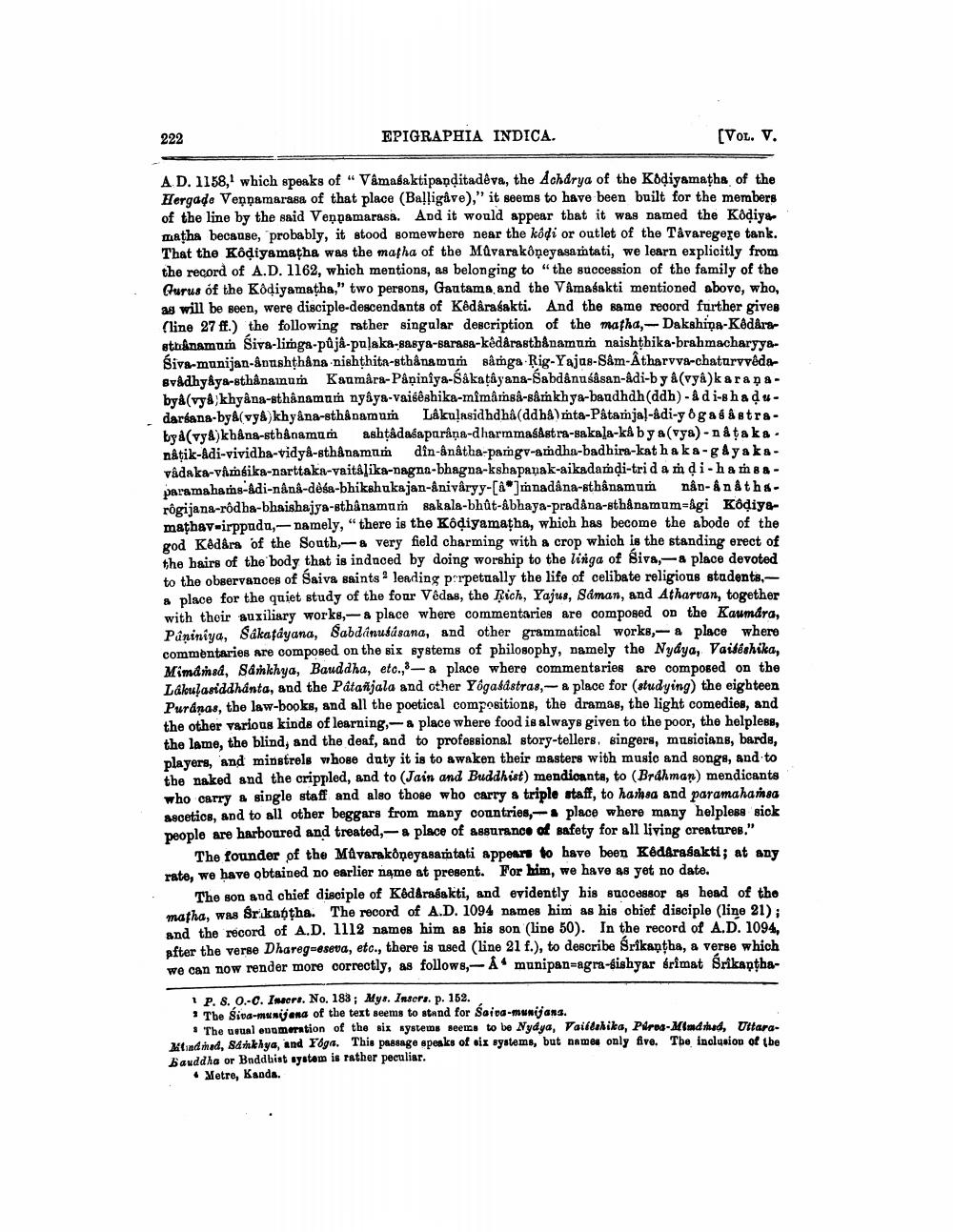________________
222
EPIGRAPHIA INDICA.
(VOL. V.
A D. 1158, which speaks of " Vámasaktipapditadêva, the Acharya of the Kodiyamatha of the Hergado Vennamarasa of that place (Balligåve)," it seems to have been built for the members of the line by the said Venpamarasa. And it would appear that it was named the Kodiye matha because, probably, it stood somewhere near the kódi or outlet of the Tåvaregere tank. That the Kodiyamatha was the matha of the Mûvarakðņeyasamtati, we learn explicitly from the record of A.D. 1162, which mentions, as belonging to the succession of the family of the Qurus of the Kodiyamatha," two persons, Gautama and the Vámasakti mentioned above, who, as will be seen, were disciple-descendants of Kedårasakti. And the same reoord further gives (line 27 ff.) the following rather singular description of the matha,- Dakshina-Kedåra sthanamum Siva-linga-pû jê-palaka-sasya-sarasa-kêdárasthånamum naishthika-brahmacharyyesiva-munijan-anushthåna nishthita-sthånamumsånga Rig-Yajus-Sâm-Atharvva-chaturvvêda BvAdhyâya-sthanamum Kaumara-Påņiniya-Sakatayana-Sabdânusâsan-di-by &(vya)karansby&(vyA;khyâna-sthanamum nyâya-vaigêshika-mimåned-sankhya-baudhdh(ddh) - 8 di-shadudarsana-by&(vyakhyana-sthånamum Lâkulasidhdha (ddbåta-Patanjal-adi-yogasastrabyà (vya)kbâns-sthanamum ashtâdaśaparåņa-dharmmaśAstra-sakala-ka bya(vya)-n &ţaks. nâţik-Adi-vividha-vidya-sthånaman din-ânâtha-pamgv-amdha-badhira-kathaka-gayakavâda ka-vimsika-narttaka-vaitålika-nagna-bhagna-kshapanak-aikadamdi-trid andi-hanaparamahams-Adi-nana-desa-bhikshukajan-âniväryy-[a]mnadâna-sthanamur nån- å nåtherôgijana-rôdha-bhaishajya-sthanamum sakala-bhůt-ábhaya-pradana-sthanamum=igi Kodiyemathav-irppudu, - namely," there is the Kodiyamatha, which has become the abode of the god Kadâra of the South,-& very field charming with a crop which is the standing erect of the hairs of the body that is induced by doing worship to the linga of Siva-a place devoted to the observances of Saiva saints a leading parpetually the life of celibate religious stadenta. - & place for the quiet study of the four Vêdas, the Rich, Yajus, Saman, and Atharvan, together with their suxiliary works, place where commentaries are composed on the Kaumdra, Paniniya, Sakafayana, Sabdanufúsana, and other grammatical works,-a place where commentaries are composed on the six systems of philosophy, namely the Nydya, Vaideshika, Mimamsd, Sankhya, Bauddha, etc., 8-place where commentaries are composed on the Lakulasiddhanta, and the Pâtafjala and other Yogatástras, - & place for studying) the eighteen Puranas, the law-books, and all the poetical compositions, the dramas, the light comedies, and the other various kinds of learning, a place where food is always given to the poor, the helpless, the lame, the blind, and the deaf, and to professional story-tellers. singers, musicians, barde, players, and minstrels whose daty it is to awaken their masters with music and songs, and to the naked and the crippled, and to (Jain and Buddhist) mendicante, to (Brahman) mendicants who carry a single staff and also those who carry a triple staff, to hashsa and paramahansa ascetics, and to all other beggars from many countries, place where many helpless sick people are harboured and treated,-a place of assurance of safety for all living creatures."
The founder of the Mavarakoneyasamtati appears to have been KedArasakti; at any rate, we have obtained no earlier name at present. For him, we have 48 yet no date.
The son and chief disciple of Kodarasakti, and evidently his successor as head of the matha, was Srikantha. The record of A.D. 1094 names him as his obief disciple (line 21); and the record of A.D. 1112 names him as his son (line 50). In the record of A.D. 1094, after the verse Dharegeseva, eto., there is used (line 21 f.), to describe Srikantha, a verse which we can now render more correctly, as follows,- A munipan-agra-fishyar brimat Srikantha
1 P. 8.0-0. Insert. No. 183; Mys. Inters. p. 152. 1 Tbe Siva-menü ana of the text seems to stand for Saida-munijans.
• The usual numeration of the six systems seems to be Nydya, Vaillshika, Piros-Mimuuad, Uttaraxundhed, Sankhya, and Yoga. This passage speaks of six systems, but names only five. The inclusion of the Bauddha or Bnddhist system is rather peculiar.
• Metre, Kanda.




